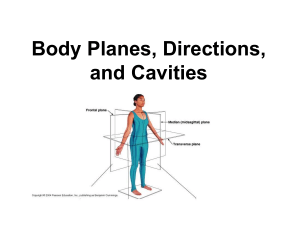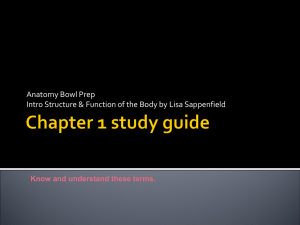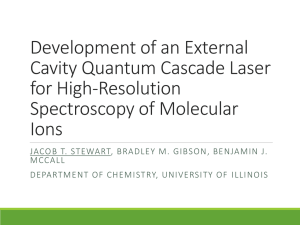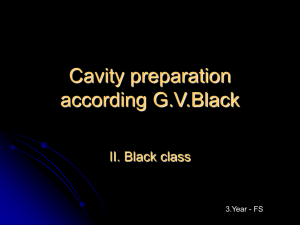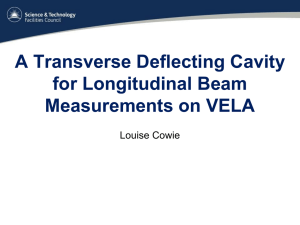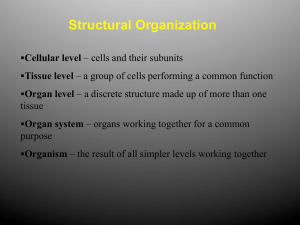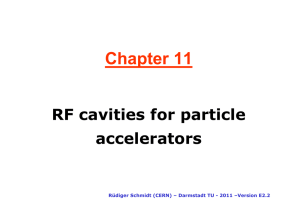Detection of NO and S-nitrosocompounds using mid
advertisement
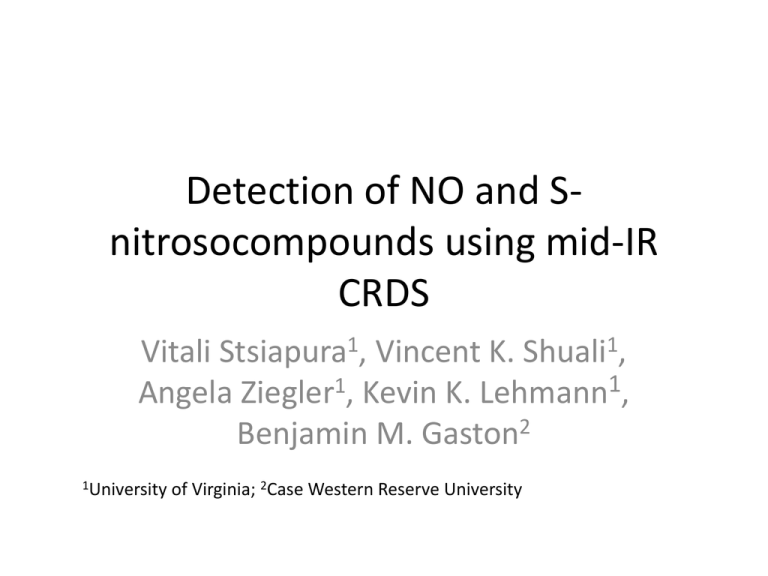
Detection of NO and Snitrosocompounds using mid-IR CRDS Vitali Stsiapura1, Vincent K. Shuali1, Angela Ziegler1, Kevin K. Lehmann1, Benjamin M. Gaston2 1University of Virginia; 2Case Western Reserve University Biochemistry of NO-containing compounds • S-nitrosothiols (RS-NO) receiving attention in biochemistry and medicine as donors of nitric oxide (NO) and nitrosonium (NO+) - physiologically active molecules involved in signal transduction through transnitrosation of thiol protein groups[1][2] • S-nitrosothiol signaling involved in various types of cellular processes, diseases, e.g. cancer, asthma, cystic fibrosis [1]Lipton. A. J., Nature, 2001 [2]Arnell, D. R., Arch. Biochem. Biophys., 1995 S-nitrosoglutathione, an S-nitrosothiol • NO can be easily released from S-nitrosothiols after exposure to UV light (340 nm), quantum efficiency up to 0.8 [3] • S-nitrosothiols concentration can be deduced by measurement of released NO amount: • 𝑅𝑆𝑁𝑂 ℎν [3]Veleeparampil, 𝑅𝑆 ∙ + .𝑁𝑂(𝑔) M., Adv. Phys. Chem., 2009 [4]Balazy, M., J. Biol. Chem., 1998 Absorbance (arb. units) NO and S-nitrosothiols Wavelength (nm) UV spectrum of synthetic GSNO[4] Motivations • Present methods of detecting NO (g) (i.e. chemiluminescence) not sensitive enough to measure concentrations released from living cells, at nanomolar levels • Ability to differentiate between isotope-labeled NO will allow tracking of NO compounds in cells and biological tissues [5]USGS NO chemiluminescence apparatus[5] Biogeochemistry of Carbon and Nitrogen in Aquatic Environments: 14NO and 15NO in 100 torr-18 air2 σ of ofcm absorption cross-section, ´10 (10-18 cm2) Mid-IR Spectroscopic detection of NO 3.5 14 R1/2(13/2) for 14NO 3.0 14NO 15NO R3/2(13/2) for 14NO 2.5 NO 15 NO H2O 100 torr He 296 K 2.0 1.5 R1/2(37/2) for 15NO R1/2(39/2) for 15NO 1.0 0.5 0.0 1899 1900 1901 1902 -1 (cm ) 1903 Frequency -1 wavenumber, cm Simulated from HITRAN data [6] 1905 1904 Cavity Ring-down Spectroscopy • Highly reflective mirrors (of 1- R < 10-4) allow light to bounce many times in cavity, whose intensity decays in time at the rate of: (1 R)c k0 L • Addition of sample with absorption coefficient α(υ)=Nσ(υ) yields: k k 0 c • Thus ringdown time is used to measure concentration N To detector IR from laser Laser RD cavity detector Description of External Cavity Quantum Cascade Laser • Model: Daylight Solutions mid-IR tunable ec-QCL Tuning range: 70 cm-1 • Line width: ~ 6 MHz Peak power to cavity: 38 mW Power (mW) [7] NO lines of interest 1940 Wavenumber (cm-1) 1880 Schematic of setup InSb detector ec-QCL (Laser) AOM Reference cell Internally-coupled Etalon InSb detector PCDAQ Trigger Mode-matching optics InSb detector Ring-down cavity isolator Cavity Ring-down scheme Cavity • AOM: R37040-3-5.4 (Gooch & Housego) • Laser deflected and freq shifted by AOM to cavity, shut off of AOM in ~ 150 ns • 0th order to reference cell and etalon for frequency calibration Cavity Ring-down scheme Cavity • AOM: R37040-3-5.4 (Gooch & Housego) • Laser deflected and freq shifted by AOM to cavity, shut off of AOM in ~ 150 ns • 0th order to reference cell and etalon for frequency calibration Optical isolation Returning beam blocked by polarizer HV applied across crystal leads to difference in refractive index between x- and y- polarizations Scan of cavity over 1.2 FSR 10 8 6 4 2 Cavity modes with isolator 0 -2 CdTe EO crystal, used as ¼ wave plate Cavity modes w/o isolator -4 0.00 0.02 0.04 0.06 time 0.08 0.10 0.12 0.14 Cavity Apparatus “Super mirrors” Cavity surfaces coated with inert coating (SilcoTekTM) PZTs to scan up to 1.4 cavity FSRs Invar plate to fix cavity length • R = 0.99975 (F ~ 12000) Mirror configuration: ZnSe mirrors with coating (LohnStar) • L = 0.35 m • V= 350 mL • FSR = 430 MHz • τ0 = 4.6 μs Gas delivery to cavity 7 μm particle filter He flow UV Lamp Flask with GSNO sample 2.9ppm NO in He tank manifold Cold trap (LN2 and ethanol slurry) 2 μm particle filter Legend: Vacuum pump NO flow Ring-down cavity Valve Observed results τ (μs) NO line R3/2(13/2) at 1900.75 cm-1 0 300 600 900 Frequency detuning (MHz) 1200 Estimate of limit of detection Allan deviation of k Min σα: 7.8 × 10-10 cm-1 Isotopic measurement 0 0.3 0.6 0.9 1.2 1.5 1.8 0 0.3 0.6 0.9 1.2 1.5 1.8 0 0.3 0.6 0.9 1.2 1.5 1.8 Frequency detuning (GHz) Conclusions • Constructed compact RD system able to measure sample concentration in seconds • Obtained limit of detection of 30 pptv, exceeding Kosterev’s limit of 0.7ppbv[10], goal to exceed Mürtz’s[11] 7 pptv level • Confirmed ability to measure 14NO and 15NO levels in same scan [10]Kosterev, A., Appl. Optics, 2001 [11]Heinrich, K., Appl. Phys. B., 2009 Future plans [9] [9]Giusfredi, G., Phys. Rev. Letters, 2010 Acknowledgments • NIH and NSF: financial support • Dr. Joseph Hodges (NIST): advice and assistance on cavity length and frequency stabilization References 1. Lipton, Andrew J., et al. "S-nitrosothiols signal the ventilatory response to hypoxia." Nature 413.6852 (2001): 171-174. 2. Arnelle, Derrick R., and Jonathan S. Stamler. "NO+, NO., and NO− donation by S-nitrosothiols: implications for regulation of physiological functions by S-nitrosylation and acceleration of disulfide formation." Archives of biochemistry and biophysics 318.2 (1995): 279-285. 3. Veleeparampil, Manoj M., Usha K. Aravind, and C. T. Aravindakumar. "Decomposition of S-Nitrosothiols Induced by UV and Sunlight." Advances in Physical Chemistry 2009 (2010). 4. Balazy, Michael, et al. "S-Nitroglutathione, a product of the reaction between peroxynitrite and glutathione that generates nitric oxide." Journal of Biological Chemistry 273.48 (1998): 32009-32015. 5. USGS Biogeochemistry of Carbon and Nitrogen in Aquatic Environments: http://wwwbrr.cr.usgs.gov/projects/EC_biogeochemistry/facilities.htm 6. Rothman, Laurence S., et al. "The HITRAN 2004 molecular spectroscopic database." Journal of Quantitative Spectroscopy and Radiative Transfer 96.2 (2005): 139-204. 7. Daylight Solutions, Inc. http://www.daylightsolutions.com 8. M. Reich, et al., Appl. Optics 25, 1986 9. Giusfredi, G., et al. "Saturated-absorption cavity ring-down spectroscopy." Physical review letters 104.11 (2010): 110801. 10. Kosterev, Anatoliy A., et al. "Cavity ringdown spectroscopic detection of nitric oxide with a continuouswave quantum-cascade laser." Applied optics 40.30 (2001): 5522-5529. 11. Heinrich, K., et al. "Infrared laser-spectroscopic analysis of 14NO and 15NO in human breath." Applied Physics B 95.2 (2009): 281-286.

